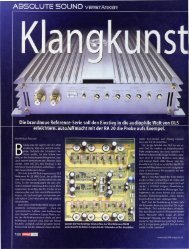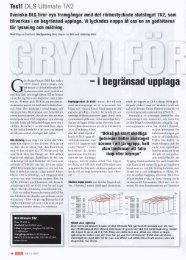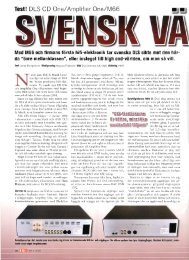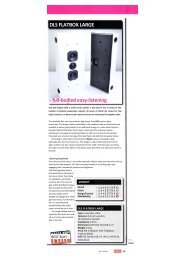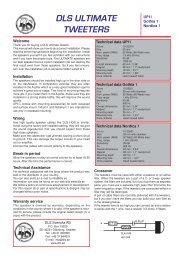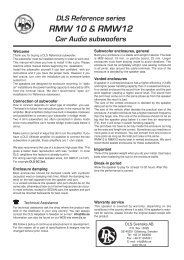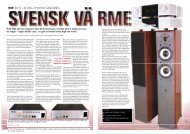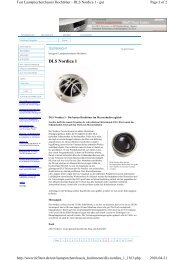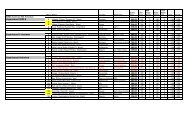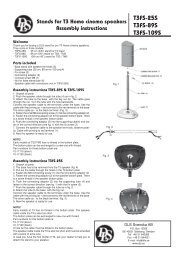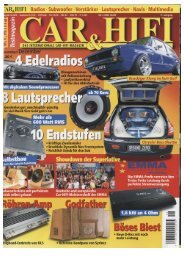DLS R60
DLS R60
DLS R60
You also want an ePaper? Increase the reach of your titles
YUMPU automatically turns print PDFs into web optimized ePapers that Google loves.
-NCFINTFS COMPACTFS 1<br />
<strong>DLS</strong> <strong>R60</strong><br />
Installée à Goteborg, en Suède, <strong>DLS</strong> fabrique ses<br />
propres haut-parleurs dont les applications s'étendent,<br />
au-delà du "car audio," à la hi-fi et au home cinéma.<br />
SPFCIFICATlONS<br />
r Type : 2 voies, 2 haut-parleurs.<br />
Charge accordée.<br />
r Haut-parleurs :<br />
H. P. de grave 0 765 mm,<br />
7 tweeter à dôme en soie 0 28 mm.<br />
Réponse en fréquence :<br />
55 - 25 kHz.<br />
r Impédance moyenne : 4 B<br />
,<br />
sensibilité : 88 d6/2,83 V/1 m.<br />
Puissance nominale : 150 W crête.<br />
Dimensions : 200 x 390 x 320 mm.<br />
Poids : 70 kg.<br />
Origine : Suède.<br />
r Pkindicatif : 800 €la paire.<br />
n que très fortement concur- Des haut-parleurs conçus<br />
sncées par des marques d'ori- et fabriqués en Suède<br />
ne asiatique, les spécialistes En concevant et en fabriquant ses<br />
~ropéens du haut-parleur et propres haut-parleurs, <strong>DLS</strong> peut ainsi<br />
d ~ ,,iceinte , acoustique ont su conser- maîtriser tous leurs paramètres en les<br />
ver leur place sur les marchés de I'audio adaotant chacun à une utilisation bien<br />
et du home cinéma en multipliant leurs<br />
efforts basés sur des connaissances de terrain<br />
dépassant parfois le demi-siècle.<br />
C'est une chose que I'on n'invente pas.<br />
Les pays scandinaves sont réputés pour<br />
figurer depuis longtemps déjà parmi les<br />
grands spécialistes du haut-parleur, bien<br />
qu'il existe çà et là des firmes qui ont<br />
grandi " tout en restant dans l'ombre<br />
des grands, en faisant leurs preuves<br />
dans un monde ~arallèle tel aue celui<br />
du "car audio". C'est notamment le<br />
cas de <strong>DLS</strong>, firme suédoise née en 1979<br />
et installée à Goteborg, un port connu<br />
oour ses chantiers navals et ses usines<br />
automobiles. 11 n'est pas impossible<br />
que cette opportunite ait poussé <strong>DLS</strong><br />
a concentré la majorité de ses activités<br />
dans les haut-parleurs pour automobiles.<br />
Ses compétences dans le "car audio", largement<br />
récompensées par de nombreux<br />
prii internationaux, ont fait comprendre<br />
à cette firme qu'une place restait à<br />
prendre dans le domaine de I'audio et<br />
du home cinéma, ce malgré la concurrence<br />
internationale. Après s'être concrétisé<br />
avec un catalogue riche en modèle<br />
que I'on pourra découvrir sur le site<br />
internet www.dls.se/english, cette firme<br />
suédoise a décidé de bien séparer les entités<br />
audiomobile et hifdhome cinéma en<br />
les confiant entre autres à des réseaux<br />
de distribution bien distincts.<br />
Récemment, Dynamic Home Cinema,<br />
une société installée à Marseille a pris<br />
en charge la distribution exclusiveAdes<br />
produits audio et home cinéma du<br />
catalogue <strong>DLS</strong>.<br />
Deux transducteurs issus non pas de la sous-traitance, mais conçus et fabriqués<br />
en Suède par l'usine <strong>DLS</strong>, celui de grave-médium ayant pour particularité de béné-<br />
ficier d'une recette très appréciée des audiophiles,une membrane en pulpe de cel-<br />
lulose non pressée. Le filtre passif fait partie des rares à utiliser des selfs à air.<br />
cadrée. On évite en plus les risques de<br />
fuites de savoir-faire, iamais nulles, ou<br />
bien de pénurie brutale de pièces déta-<br />
chées suite au dépôt de bilan d'un sous-<br />
traitant.<br />
La version booshelf<strong>R60</strong> est réalisée en<br />
parois de MDF de 20 mm décorée<br />
d'une finition vinyle. Un cloisonne-<br />
ment partiel, situé entreles deux haut-<br />
parleurs, permet d'allonger le par-<br />
cours de l'onde interne iusau'à l'évent<br />
I I<br />
dorsal. Ses faces internes sont amor-<br />
ties de olaaues bitumineuses.<br />
1 .<br />
Le haut-parleur de grave-médium de<br />
0 165 mm, monté sur saladier en<br />
métal newuré protégé d'une peintu-<br />
re noire, est l'un des rares du genre à<br />
faire usage d'une membrane en pulpe<br />
de cellulose non pressée à fibres<br />
longues. Cerclée d'une suspension en<br />
forme de demi-rouleau convexe en<br />
caoutchouc de butyle et renforcée par<br />
un cache noyau concave, elle est acti-<br />
vée par une bobine mobile à course<br />
longue de 0 30 mm. Son circuit<br />
magnétique généreux utilise deux gros<br />
aimants ferrite de 0 100 mm, dont un<br />
monté en opposition de polarité ser-<br />
vant à augmenter le champ dans<br />
I'entrefer tout en minimisant les fuites<br />
magnétiques, un point important dans<br />
le cadre d'une utilisation en home<br />
cinéma.<br />
Le tweeter, conçu et fabriqué lui aussi<br />
en Suède par <strong>DLS</strong> utilise un dôme<br />
textile trks souple et léger de 28 mm<br />
de diamètre. Son circuit magnétique<br />
met à contribution un noyau magné-<br />
tique décompressé et amorti pour évi-<br />
ter les résonances de cavité, le trou de<br />
décompression central communiquant<br />
avec un volume dorsal clos et amorti.<br />
Placé au dos du bornier double avec<br />
straps amovibles en cas de bi-câblage<br />
et contacts dorés, il adopte la formu-<br />
le du second ordre de 12 dB/oct. II uti-<br />
lise deux selfs à air, deux condensateurs<br />
portant la marque <strong>DLS</strong> ainsi que trois<br />
résis tances.<br />
Jean Hiraga<br />
CONSEILS<br />
D'UT1 USATION<br />
A placer sur des pieds avec twee-<br />
ters B hauteur d'oreilles. Ajuster la<br />
distance par rapport au mur arriè-<br />
re jusqu'B obtention du meilleur<br />
équilibre spectral.<br />
No 31 4s janvierlfévrier 07
unilAIN BUTHlGlEG<br />
que suédoise de renom, <strong>DLS</strong> offre<br />
un catalogue riche. Parmi les réfé-<br />
rences que l'on trouve sur le site en<br />
ligne du constructeur, on reste<br />
impressionné par l'esthétique de cer-<br />
taines enceintes comme la série D3.<br />
La <strong>R60</strong>, quant à elle, est de facture plus classique.<br />
Mais la qualité de fabrication est au rendez-vous. Ici,<br />
le constructeur suédois utilise des haut-parleurs pro-<br />
duits dans sa propre usine. C'est d'autant plus remar-<br />
quable que le coût de revient reste maîtrisé. Autre<br />
point fort de l'enceinte, sa membrane en pulpe de cel-<br />
lulose non pressee à fibres longues sur son haut-par-<br />
leur de grave-médium. etention, elle mérite un bon<br />
rodage pour se libérer. A l'écoute, la <strong>DLS</strong> présente un<br />
style d'écoute trés différent de ce à quoi je suis habi-<br />
tué. Cela se retrouve aux mesures. Ce particularisme<br />
aura ses adeptes et ses détracteurs : l'aigu, par<br />
exemple, est d'une grande qualité, le medium semble<br />
par moments en retrait, le<br />
rapide mais un peu court (alors<br />
que le volume de la charge est<br />
loin d'être négligeable). Mais<br />
sur ces points, le placement de<br />
I'enceinte joue un r81e d'une<br />
grande importance. Une<br />
marque à découvrir en détail.<br />
MESURES<br />
1 GRAVE<br />
P JEAN HIRAGA<br />
<strong>DLS</strong>, une marque trés populaire dans<br />
le domaine du "car audio" a profité de<br />
ses connaissances pour les étendre<br />
aux marchés de l'audio et du home<br />
cinéma tout en prenant au passage le<br />
1 - soin de bien separer les entités, la<br />
distribution pour la France des produits audio et<br />
home cinéma étant confiée à Dynamic Home Cinéma,<br />
une société installée a Marseille. Un peu plus grande<br />
que la R50, une entrée de gamme trés bien cotée, la<br />
<strong>R60</strong> s'est distinguée des modéles sélectionnés dans<br />
ce dossier par un équilibre spectral différent mais<br />
agréable, lié en partie A une reponse amplitudelfré-<br />
quence un peu relevée (volontairement ?), entre 400<br />
et 800 Hz, comme l'ont montré les résultats de mesu-<br />
re. Le test d'écoute révéle un effet physiologique trés<br />
savamment dosé, juste assez pour 'agrandir" virtuelle-<br />
ment la taille des enceintes, pour apporter aux<br />
ambiances un léner complément d'espace, de cha-<br />
ieur, mieux que sur bien des<br />
compactes de cet ordre de<br />
taille. Deux précautions sont<br />
A prendre : ne pas écouter<br />
SOUS un niveau sonore<br />
trop 6levé et se placer<br />
exactement à la hauteur des<br />
tweeters.<br />
Réponse amplitude1 fré-<br />
quence à 1 ml dans l'axe,<br />
à 0' et 30' de I'enceinte<br />
<strong>DLS</strong> <strong>R60</strong> : Sensiblité de<br />
l'ordre de 89 dB12,83 VI1 m.<br />
Réponse peu tourmentée en<br />
milieu de bande.. Léger rele-<br />
vé de I'aigu au-dessus de<br />
15 kHz et entre 400 et<br />
700 Hz (des effets voulus 3).<br />
Réponse amplitude1<br />
frdquence en tiers d'octa-<br />
ve, à 1 m, dans l'axe,<br />
de I'enceinte <strong>DLS</strong> <strong>R60</strong> :<br />
Les remarques faites plus<br />
haut sont moins visibles, la<br />
mesure en milieu semi-réver-<br />
bérant apportant des diffé-<br />
rences sensibles selon la<br />
position de l'enceinte.<br />
Réponse sur impulsion<br />
de I'enceinte <strong>DLS</strong> <strong>R60</strong> :<br />
Réponse trés correcte,<br />
montrant seulement un léger<br />
décalage temporel de la voie<br />
de grave-médium par rapport<br />
au tweeter.<br />
Caractéristique d'impé-<br />
dance en fonction de la<br />
frdquence de l'enceinte<br />
<strong>DLS</strong> <strong>R60</strong> :<br />
Fréquence d'accord située<br />
vers 46 Hz, avec résonances<br />
amorties d'amplitude proche.<br />
Le module d'impédance<br />
mesuré est de 5,9 8.<br />
EQUIUBR~GENE<br />
Ella Fitzgerald " rceacn for<br />
Tornorrovd', Verve Classic<br />
Compact, VSCD 4043.<br />
R.B. La voix d'Ela s'établit avec<br />
facilité, toutefois, je décéle à mon<br />
goCit une pointe de clarté. Le piano<br />
reste linéaire, les modulations sont<br />
assez précisément restituées.<br />
Toutefois, il semble y avoir un lbger<br />
creux dans le médium qui modifie la<br />
sensation à l'écoute.<br />
J.H. Avec ce premier test, on<br />
inaugure un style d'écoute doux et<br />
Iégérement feutré, mais trés<br />
agréable, qui tend à renforcer plus<br />
que d'habitude le "feeling" jazz de<br />
cette ancienne prise de son. La voix<br />
et le piano ont un peu reculé tout en<br />
consewant une bonne définitioi<br />
.ERET e<br />
Juan dd -banc-<br />
riew, BNL 11 2 848.<br />
R.B. La scéne sonore est étalée d'un<br />
point de vue latbral, la profondeur<br />
semble en revanche un peu courte.<br />
Le résultat reste cependant trés<br />
correct. Le grave aurait gagné à avoir<br />
un peu plus d'impact. En modifiant<br />
l'emplacement des enceintes et la<br />
position dtBcoute, on arrive à trouver<br />
un bon Sweet point.<br />
J.H. On apprécie de nouveau le trés<br />
bon feeling général, probablement<br />
dû en partie à la plage de médium<br />
subtilement en retrait, l'écoute dans<br />
l'axe des enceintes apportant un<br />
piqué qui tend à minimiser cette<br />
impression. Bien, mais assez doux.<br />
R#UemwwsArEE<br />
mark Curry, Ws only tirne, plage<br />
1, "Al1 over MelV,Virgin CDVUS 49.<br />
I<br />
-<br />
1 2 3 4 5<br />
m RB. m J.H.<br />
DYNAMIQUE SUBJECTIVE , =<br />
DEFlNiïlON , -- I<br />
l===<br />
EFFET STÉREOPHONIQU~ =<br />
COHERENCE DES REGISi nd '<br />
RAPPORT QUALITEIPRIX<br />
NOUS AVONS AIME<br />
I La fabrication industrielle et soignée.<br />
I La qualité des haut-parleurs.<br />
I L'équilibre tonal à bas niveau.<br />
NOUS AURIONS APPRECIÉ<br />
I Un son encore plus charpenté et articulé.<br />
I Une première octave encore plus affirmée.<br />
R.B. Bonne restitution de la voix de<br />
Mark Curiy sur la partie solo avec sa<br />
guitare. Lorsque les autres<br />
instruments arrivent, la <strong>R60</strong> réussit à<br />
tirer son épingle du jeu.<br />
J.H. La <strong>R60</strong> se sort vraiment trés<br />
bien de ce test : voix bien présente et<br />
détourée, pas projetée et située<br />
entre les enceintes, en premier plan.<br />
Les accompagnements suivent sans<br />
traîner. Un piége bien surmonté.<br />
REWNSE EN FREQUENCE<br />
Applaudissements, tests de per-<br />
cussions. Disque NRDS nO1O,<br />
plages 14,17 et 21.<br />
R.B. Applaudissements<br />
correctement restitués, profondeur<br />
ajustée avec précision. Clochette<br />
fine et racée, point fort indéniable de<br />
la <strong>R60</strong>. Percussions qui me semblent<br />
manquer d'envergure dans le grave,<br />
mais belle sensation de matiere sur<br />
i'extinction de la vibration.<br />
J.H. En se plaçant juste à la hauteur<br />
des tweeters et sous un niveau<br />
d'écoute moyen, ces trois tests sont<br />
bien surmontés, y compris la grosse<br />
caisse qui diminue seulement un peu<br />
de diamètre.<br />
iFumDEIl<br />
mMwAlma<br />
Johann Strauss, "Marche<br />
Egyptienne" Op. 335, Das<br />
Mikrofon, plage 2, Tacet 17.<br />
RB. Si les pupitres se détachent<br />
bien, il reste à mon goOt un manqu<br />
d'envergure de I'enceinte (rodage'<br />
Fusion correcte des registres.<br />
J.H. Un resultat plus que positif, mi<br />
obtenu en respectant les indicatior<br />
ci-dessus: bien équilibré, acoustiq 1 -<br />
de salle prbente juste comme il le<br />
faut, grive plein et correctement<br />
assis, orchestre bien timbré.
AUDIO FILE<br />
COMPACT ENCLOSURES<br />
<strong>DLS</strong> <strong>R60</strong><br />
Situated in Gothenburg, Sweden, <strong>DLS</strong> manufactures its own loudspeakers whose applications<br />
extend, beyond “car audio”, to the HiFi and home cinemas.<br />
SPECIFICATIONS<br />
> Type: 2 ways, 2 loudspeakers.<br />
Bass reflex.<br />
* Loudspeakers:<br />
Bass loudspeakers ∅ 165 mm,<br />
1 tweeter with silk dome ∅ 28 mm<br />
* Frequency response:<br />
55 - 25 kHz.<br />
> Average impedance: 4 Ω<br />
> Sensitivity: 88 dB/2.83V/1 m.<br />
> Nominal output: 150 W peak.<br />
* Dimensions: 200x390x320mm.<br />
> Weight: 10kg.<br />
* Made in Sweden.<br />
> RRP: 800 € the pair.<br />
Although very subject to strong competition from makes of Asian origin, the European loudspeaker and<br />
loudspeaker enclosure specialists know how to maintain their place on the audio and the home cinema<br />
markets by multiplying their efforts based on knowledge and experience reaching back a half century.<br />
This is something which one does not just add up. The Scandinavian countries are well-known for being<br />
among the major loudspeaker specialists for a long time, although there firms here and there which grew<br />
up while remaining in the shadow of the large ones, by proving their reputation in a parallel world such as<br />
that of “car audio”. It is particularly the case of <strong>DLS</strong>, a Swedish firm founded in 1979 and situated in<br />
Gothenburg, a port known for its shipyards and its automobile factories. It is not impossible that this<br />
opportunity forced <strong>DLS</strong> to concentrate the majority of its activities on loudspeakers for cars. Its<br />
competence in “car audio”, widely rewarded by many international prizes, makes one understand there<br />
was a place for this firm to take in the fields of audio and home cinema, in spite of international<br />
competition. After establishing itself with a catalogue rich in models which can be found on its Internet<br />
site at www.dls.se/english, this Swedish firm decided to completely separate the audio-mobile and<br />
HiFi/home cinema entities by entrusting them to quite distinct distribution networks. Recently, Dynamic<br />
Home Cinema, a company located in Marseilles has taken charge of the exclusive distribution of the audio<br />
and home cinema products in the <strong>DLS</strong> catalogue.<br />
Two transducers produced, not by subcontracting, but designed and made in Sweden by the <strong>DLS</strong> factory,<br />
the bass-midrange driver has characteristics benefiting from a recipe much appreciated by audiophiles,<br />
an uncompressed cellulose pulp diaphragm. The passive filter is one of the rare ones that use air-cored<br />
inductors.<br />
Loudspeakers designed and made in Sweden<br />
In designing and manufacturing its own loudspeakers, <strong>DLS</strong> can thus control all their parameters by<br />
adapting them each one to a closely-defined use. One also avoids the risks of loss of know-how or of<br />
shortage of spare parts following the loss of a subcontractor.
The book shelf version of the <strong>R60</strong> has walls of 20 mm MDF decorated with a vinyl finish. A partial<br />
bracing, located between the two drivers, makes it possible to lengthen the course of the internal sound<br />
waves to the rear vent. Its internal faces are damped by bituminous panels. The bass-midrange driver of ∅<br />
165 mm, assembled on a corrugated metal frame protected by black paint, is one of rare kind to make use<br />
an un-compressed cellulose pulp diaphragm with long fibres. Ringed by a surround in the shape of convex<br />
half-roll of butyl rubber and reinforced by a concave mask core, it is activated by a long throw voice coil<br />
of ∅ 30 mm. Its generous magnet system uses two large ferrite magnets of ∅ 100 mm, but installed in<br />
opposite polarity, to increase the field in the air-gap while minimising the stray magnetic field, a<br />
significant point in the home cinema field.<br />
The tweeter is also designed and manufactured in Sweden by <strong>DLS</strong>, uses a very flexible and light textile<br />
dome of 28 mm diameter. Its magnet system uses an uncompressed and damped magnetic core to avoid<br />
cavity resonances, the central decompression hole communicates with a closed and damped volume<br />
behind.<br />
The passive crossover filter<br />
The crossover is placed at the back of the double connector block with gold-plated connectors, and<br />
removable jumpers for bi-wiring. It adopts the second order slope of 12dB/oct. It has two air-cored coils,<br />
two capacitors carrying the <strong>DLS</strong> name and three resistors.<br />
Jean Hiraga<br />
UTILISATION ADVICE<br />
Place them on stands, with tweeters at the height of your ears. Adjust the distance compared to the wall<br />
until you get the best tonal balance.<br />
REVUE DU SON<br />
HOME CINEMA<br />
No. 314S January/February 07<br />
< page 2 ><br />
OUR OPINION<br />
ROMAIN BUTHIGIEG<br />
A renowned Swedish brand, <strong>DLS</strong> offers a rich catalogue. Among the references which one finds on the<br />
manufacturer’s web site, one remains impressed by the aesthetics of certain enclosures such as the D3<br />
series. As for <strong>R60</strong>, it is of more traditional design. But the quality of manufacture is spot-on. Here, the<br />
Swedish manufacturer uses loudspeakers produced in their own factory. It is all the more remarkable since<br />
the cost of production remains controlled. Another strong point of the drivers is its un-compressed<br />
cellulose pulp diaphragm with long fibres in its bass-midrange driver. But look out, it deserves long<br />
breaking-in to show it's best. When listening, the <strong>DLS</strong> presents a style of listening very different from<br />
what I am used to. This is found in the measurements. This characteristic will have its followers and its<br />
opponents: the treble, for example, is of a great quality, the midrange seems at times to be a bit weak, the<br />
bass is fast but a little reserved (even though the amount is far from being negligible). But in addition to<br />
these points, the positioning of the speakers is of great importance. A brand to be discovered in detail.
JEAN HIRAGA<br />
<strong>DLS</strong>, a very popular brand in the field of “car audio” benefited from its knowledge to extend its range to<br />
the audio and home cinema markets while at the same time taking care to separate the entities well. The<br />
distribution of the audio products and home cinema in France being entrusted to Dynamic Home Cinema,<br />
a company located in Marseilles. As it is a little larger than the R50, a very well dimensioned entry model<br />
in the range, the <strong>R60</strong> distinguished itself from the models selected in this file by a different but pleasant<br />
tonal balance, partly linked to a slightly raised amplitude/frequency response (voluntarily?), between 400<br />
and 800 Hz, as was shown by the measurement results. The listening test showed a very carefully<br />
proportioned physiological effect, to virtually “increase just enough” the size of the enclosures, to give the<br />
environments a light supplement of space and warmth, better than on many compacts of this size. Two<br />
precautions should be taken: do not listen to an excessive sound level and put yourself exactly at the same<br />
level as the tweeters.<br />
BASS MIDRANGE TREBLE<br />
MARKS (OUT OF 5)<br />
RB/ J.H. 1 2 3 4 5<br />
SUBJECTIVE DYNAMICS 4/3<br />
DEFINITION 4/4<br />
STEREO IMAGE 3/4<br />
TONAL BALANCE 3/3<br />
QUALITY/PRICE RATIO 3/4<br />
WE LIKED:<br />
The manufacturing quality.<br />
The quality of the loudspeakers.<br />
Tonal balance at a low sound levels.<br />
WE WOULD HAVE APPRECIATED:<br />
An even more defined and articulated sound.<br />
A first octave which was more noticeable.<br />
MEASUREMENTS<br />
Response amplitude/frequency at 1 m on the axis, at 0° and 30° from the enclosure<br />
<strong>DLS</strong> <strong>R60</strong>:<br />
Sensitivity of about 89 dB/2.83 V/1 m. Slightly tormented midrange response. Lightly raised treble above<br />
15 kHz and between 400 and 700 Hz (desired effects?).<br />
Response amplitude / frequency in third octaves, at 1 m, along the axis of the enclosure<br />
<strong>DLS</strong> <strong>R60</strong>:<br />
The remarks above are less visible; measurement in the middle of the resonant area brings substantial<br />
differences according to the position of the enclosure.<br />
Impulse response in the <strong>DLS</strong> <strong>R60</strong> enclosure:<br />
Very correct response, showing only one light temporal shift in the bass-midrange response compared to<br />
the treble.
Impedance characteristic of corresponds with the frequency of enclosure<br />
<strong>DLS</strong> <strong>R60</strong>:<br />
Tuned frequency located at 46 Hz, with damped resonance at close amplitude. The measured impedance<br />
is 5.9 Ω.<br />
CRITICAL LISTENING<br />
NEUTRALITY, GENERAL BALANCE<br />
Ella Fitzgerald “Reach for Tomorrow”, Compact Classic Liveliness, VSCD 4043.<br />
R.B. Ella’s voice is established with facility; however, I feel that I detect a dip in clarity. The piano<br />
remains linear; the modulation is rather precisely reproduced. However, it seems to have a light dip in the<br />
midrange which modifies the listening experience.<br />
J.H. In this first test, one inaugurates a style of gentle listening, slightly muted, but very pleasant, which<br />
tends to reinforce the jazz “feel” of this old sound recording more than usually. The voice and the piano<br />
were slightly moved back while preserving a good definition.<br />
STEREOPHONIC EFFECT<br />
Juan del Encina, “Solo de batterie”, BNL 112 848.<br />
R.B. The sound-scape is spread out to the sides; the depth seems a little short on the other hand. The result<br />
remains very correct, however. The bottom end would have gained if it had a little more impact. When the<br />
positioning of the enclosures and the listening position are tweaked, one manages to find a good sweet<br />
spot.<br />
J.H. Once again appreciates the very good general feeling, probably due partly to the subtly withdrawn<br />
midrange, listening along the axis of the enclosures brings a sting which tends to minimise this<br />
impression. Good, but rather soft.<br />
DYNAMIC BEHAVIOUR, BEHAVIOUR DURING HIGH SOUND LEVELS<br />
Mark Curry, “It's only time”, track 1, “All over Me”, Virgin CDVUS 49.<br />
R.B. Good reproduction of the Mark Curry’s voice on the solo part with his guitar. When the other<br />
instruments begins, <strong>R60</strong> succeeds in playing its game well.<br />
J.H. <strong>R60</strong> really comes out very well in this test: quite present and well modulated voice, projected and not<br />
located between the enclosures, in the foreground. The accompaniments follow without trailing. A pitfall<br />
expertly surmounted.<br />
FREQUENCY RESPONSE<br />
Applause, percussion tests. Disc NRDS No 10, tracks 14, 17 and 21.<br />
R.B. Correctly restored applause, depth adjusted with precision. The small bell was fine and distinct, an<br />
undeniable strong point of the <strong>R60</strong>. Percussion which seem me to lack power in the bass register, but<br />
beautiful substantial feel when the vibration dies out.<br />
J.H. If you place yourself just at the level of the tweeters and use a below average listening level, these<br />
three tests are easily passed, including the large case which only slightly reduces the diameter.<br />
FUSION OF THE REGISTERS, TRANSPARENCY<br />
Johann Strauss, “Egyptian March” Op 335, Das Mikrofon, track 2, Tacet 17.<br />
RB. If the enclosures are well separated, there remains in my view a lack of calibre in the speakers<br />
(breaking in?)<br />
Correct phasing of the drivers.<br />
J.H. A more than positive result, but partly obtained by respecting the indication above: well balanced,<br />
room acoustics presented just the way they are needed, treble is rich and correctly placed, good sounding<br />
orchestra.
N° 31 4s January/February 07<br />
REVUE DU SON<br />
HOME CINEMA



